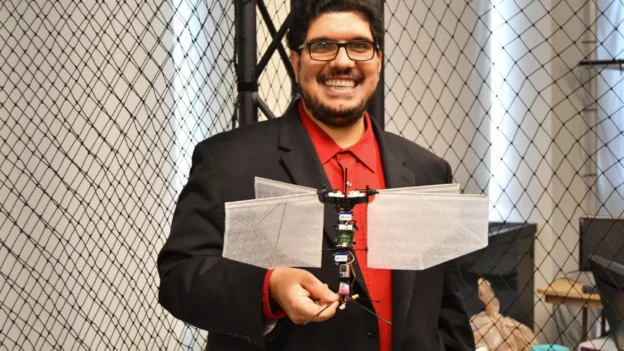A team of researchers at the University of Cincinnati has developed a moth drone with flapping wings that mimics the flight of these insects. flight of these insectsand does so without resorting to artificial intelligence or global positioning systems. The device uses an end-finding feedback system to hover in the air and follow moving light sources with surprising accuracy.
How does the moth drone fly as an insect without a complex brain?
This biomimetic drone requires no maps or complex calculations. Instead, it applies real-time control through constant flapping adjustments. This approach, inspired by the natural behavior of insecinse cts such as bumblebees, dragonflies and hummingbird moths, makes it possible to maintain stability during hovering flight and even to follow a moving target.
The researchers observed that, like insects, the drone generates voluntary perturbations to analyze its environment and improve its performance. This oscillation is not a defect, but an intentional function that allows for constant performance-based corrections.
Minimalist technology, precise results
The system is based on independent adjustments of the number of flaps per second and wing angle. Thus, it controls roll, pitch and yaw without external sensors or predictive algorithms. All control is through direct and continuous feedback.
We wanted to understand how such small creatures achieve such complex maneuvers.
Said Sameh Eisa, professor of engineering at UC.
This model-free, AI-free principle offers clues to the flight mechanisms of insects with tiny brains.
Potential for covert surveillance and autonomous microdrones
The prototype’s miniaturization and efficiency make it attractive for surveillance and exploration applications in environments where conventional drones cannot operate. Thanks to its low power consumption and accuracy, it represents a viable alternative to heavier, computer-dependent systems.
The research, published in the journal Physical Review EThe research, published in the journal Physical Review E, suggests that this navigation model can be extended to other robotic systems that require continuous adaptation without the need for artificial learning.
Concluding remarks
This development not only opens a new avenue for the design of autonomous drones autonomous drones lighter drones, it also suggests that certain evolutionary principles may be present in other species beyond insects. Understanding this connection between biology and robotics is the next challenge facing the University of Cincinnati team.
Source and photo: University of Cincinnati

